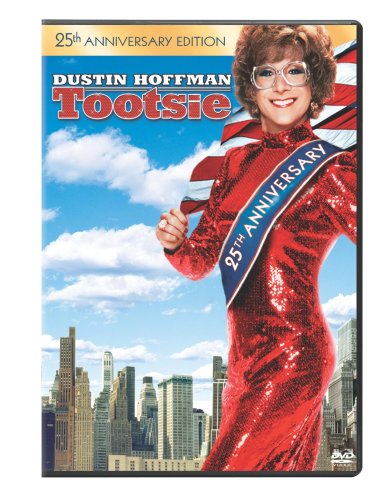- RT @ramseyshow: RT @E_C_S_T_E_R_I_: "Stupid has a gravitational pull." -D Ramsey as heard n NPR. I know many who have not escaped its orbit. #
- @BudgetsAreSexy KISS is playing the MINUTE state fair in August. in reply to BudgetsAreSexy #
- 3 year old is "reading" to her sister: Goldilocks, complete with the voices I use. #
- RT @marcandangel: 40 Useful Sites To Learn New Skills http://bit.ly/b1tseW #
- Babies bounce! https://liverealnow.net/hKmc #
- While trying to pay for dinner recently, I was asked if other businesses accepted my $2 bills. #
- Lol RT @zappos: Art. on front page of USA Today is titled "Twitter Power". I diligently read the first 140 characters. http://bit.ly/9csCIG #
- Sweet! I am the number 1 hit on Ask.com for "I hate birthday parties" #
- RT @FinEngr: Money Hackers Carnival #117 Wedding & Marriage Edition http://bit.ly/cTO4FU #
- Nobody, but nobody walks sexy wearing flipflops. #
- @MonroeOnABudget Sandals are ok. Flipflops ruin a good sway. 🙂 in reply to MonroeOnABudget #
- RT @untemplater: RT @zappos: "Do one thing every day that scares you." -Eleanor Roosevelt #
Financial Pet Peeve: Fees To Receive Paper Bank Statements
Today’s post is written by Tim of Faith and Finance. It was written for a blog swap run by the Yakezie personal finance blog network to answer the question “What is your biggest financial pet peeve?“
Chances are, you’ve probably received a few notices from your bank or investment company about receiving e-statements. I’m all for getting less mail, and having online access to my statements is a really nice feature. In fact, most of my statements are online now.
So why is it a pet peeve if I LIKE viewing statements online? Here’s why: If you don’t get the online version of your statements, many places will charge you for the paper statement. My bank (which will go unnamed) pulled this very move. If you want to receive paper statements you had to pay a few dollars each year for the ‘service.’ Now I understand that printing statements costs money, but what bothers me the most is that the bank continues to send junk mail even though I opted in to the e-statements.
It seems a little impolite to say “You have to stop using paper…but we’ll keep sending you stuff you don’t want in the mail.” Each time they send me something in the mail promoting a new product or those goofy cash advance checks, I think about how much money they’re NOT saving.
***Ok ok, I’ll stop ranting. That’s what happens when you’re challenged to write about a pet peeve…you get a little excited. 🙂
Solutions to the problem
I’m a firm believer that if you’re going to complain about something, you should be willing to suggest alternatives, so here’s what I’d do differently if I were the banks.
- 1. Don’t punish for paper statements, incentivize for online statements
If you want to connect with people online and save money in the long run, provide an incentive to make the shift to online statements. Money and interest rates talk, so maybe provide $5 plus access to a higher paying certificate only available for our online banking members.
- 2. Consolidate the message.
If people want to get paper statements still, don’t charge them – instead, use the statement envelope to promote your products. The envelope is already paid for, so why not use it for marketing purposes. Now I know they’ll say, “people don’t read statement stuffers.” To that I’d say, “what makes you think they’d read a dedicated mailer then?”
Those are my two cents. Has anyone thought the same thing? How do you feel about paper statements vs. online statements?
[Jason’s note: There is a fee that irritates me a lot more than paying to get a paper statement. I hate “online access” fees. Those are the fee where you get charged for other people doing less. They are usually called convenience fees or, in the case of government, technology fees.]
Tootsie – Does Beauty Have to be Expensive?

Many remember Dustin Hoffman dressed in drag in the classic film Tootsie, a movie that he now says made him realize how many women he’s missed out on meeting in life simply because he judged them by their looks. Every year women spend thousands of dollars on beauty products and cosmetics, hoping to increase their appearance and become attractive enough to the outside world. Although there are various degrees of beauty, it undoubtedly is usually determined by the amount of money spent to enhance features and upkeep the overall look.
The length of a woman’s hair often creates a more attractive look in the U.S., which is difficult to achieve with flat irons and curlers that create breakage and brittle hair from the heat. Women are now resorting to having hair extensions installed every three to five months to achieve beautiful hair that has a fuller texture and longer length, costing an average of $700. They can resort to shorter hair that saves a large amount of money, but they’re ultimately compromising a large part of their looks.
There’s a reason that celebrities appear more beautiful than the rest of the population, as their high school photos often show them to look like typical people. By spending thousands of dollars on personal trainers, stylists, and makeup artists, their appearance is immediately enhanced with the finest tools and products on the market. They are also able to have help with experts who have more knowledge on what creates the best look for their features.
Although beauty does not have to be expensive (just look at exotic women in Columbia and Brazil who are anything but high maintenance), it unfortunately is a requirement in the U.S. where rich housewives rule the reality shows and runways. True beauty is often defined by breast and waist sized, which few women can live up to, resulting in thousands of dollars spent on breast implants and liposuction, often impossible to attain otherwise.
Beauty may be in the eye of the beholder, but few men will argue that Angelina Jolie is unattractive or that Heidi Klum looks homely. The majority of men can agree when a woman is beautiful, and few women catch attention with a homemade manicure and dyed hair that came from a box. Perhaps going au natural will become a new trend in the coming years, but for now it’s expensive to be a woman, and even more costly to be a beautiful one.
Related articles
WWE: Money in the Bank, or all Hype?
Most people will never realize what it’s like to lose $350 million in a single day, but if you’re Vince McMahon you know the feeling all too well. However, before you start collecting money to give to the WWE CEO, let’s remember that despite that setback he’s still worth a cool $750 million. So while he got knocked out of the billionaire’s club, he’s still a full-fledged member of the multi-millionaire’s club.

However, despite the rough financial spot in the road, don’t think the WWE is ready to tap out anytime soon. The WWE Network, an on-demand streaming service launched by the company earlier this year, is already approaching one million subscribers. Despite what will probably be an initial loss of $50 million for the fledgling network, McMahon and other WWE executives believe the network will eventually become a money-maker for the company.
So while Triple H, the Rock and John Cena have helped make the WWE what it is today, there are many other superstars who are helping take the company to even greater heights. In recent years, perhaps none are more well-known and liked than the company’s Divas. Whoever said sex sells sure knew what they were talking about, because it seems the wrestling fans simply can’t get enough of the beauties who fight it out every week for glory and gold. With the show Total Divas on the E! Network for the next several years, fans will continue to get their weekly dose of the ring beauties there as well as on the other shows in the WWE camp.
So while it’s not money in the bank that all of the company’s ventures will pan out as hoped, it’s a good bet Mr. McMahon and those associated with the WWE will continue to figure out what fans are wanting and deliver it to them on a regular basis. And whether or not you are a wrestling fan, you’ve got to admit the WWE is a captivating experience in sports entertainment that keeps fans coming back for more each and every week.
Related articles
A Late-Blooming Career Cut Short: Dennis Farina Passes at 69
Dennis Farina’s acting career was unique in Hollywood as one of the few actors to garner success later in life. This “late-bloomer” started his acting career at 37 years old, after almost 20 years as a Chicago police officer. He

was well known as a character actor, playing a cop on NBC’s “Law & Order,” and one of the only cast members that had been on the police force in real life.
Dennis was born on February 29, 1944 to Italian parents in Chicago. His father, Joseph, was a doctor and an immigrant from Sicily. This leap-year baby would go on to serve 3 years in the military and then to serve his native city as a policeman from 1967 to 1985. He worked mostly in burglary and it was there that he was hired by director Michael Mann as a consultant for the movie “Thief” (1981), starring James Caan. Farina was given a bit part in the movie and would go on to work for Mann in future roles. After a brief stint acting in Chicago theater, he left the police force for a lead role in Mann’s television series “Crime Story” (1986). He also played mobster Albert Lombard in Mann’s other television show, “Miami Vice.”
Farina’s distinguishing looks made him perfect for his roles as a cop or a gangster. He was tall and imposing, with a memorable silver mustache. He worked steadily in both television and the movies after quitting the Chicago police force. His first major movie role was another Michael Mann movie, “Manhunter”(1986), in which he played an FBI agent. This was the first of the Hannibal Lecter films and Farina would go on to star in all three.
Farina’s most memorable movie roles were in 1998’s “Saving Private Ryan” in which he played a colonel who convinces Tom Hank’s character to rescue Private Ryan from the Nazis. He was known for his comedy roles as well as his serious characters. In “Get Shorty,” Farina received an American Comedy Actor award for his performance as “Ray ‘Bones’ Barboni, John Travolta’s rival.
Dennis Farina’s other screen credits include “Out of Sight” with Jennifer Lopez; John Frankenheimer’s “Reindeer Games,” Guy Ritchie’s “Snatch,” as well as the 2008 comedy, “Bottle Shock”. He was narrator for the TV show “Unsolved Mysteries,” replacing Robert Stack as the original host. Farina starred alongside Cameron Diaz and Ashton Kutcher in “What Happens in Vegas” (2008). Another comedic role was in HBO’s “Empire Falls,” starring Helen Hunt and Ed Harris. His last recurring TV role was in “Luck,” the 2012 horse racing series.
Farina and his wife of 10 years, Patricia, had three sons. Joseph Farina followed in his father’s footsteps and became an actor. And sadly, Dennis Farina’s second act in life came to a close on July 22, 2013. He was only 69 years old when he died from a pulmonary embolism at his home in Scottsdale, Arizona.
Related articles
Bribes vs Rewards

What’s the difference between a bribe and a reward? It’s a question that has been heavily on my mind lately. As a father of three–1, 3 and 10–motivating children occupies a lot of my thoughts. Is it possible to motivate a child and reward good behavior without resorting to a bribe?
First, let’s look at the definitions:
bribe n.
1. Something, such as money or a favor, offered or given to a person in a position of trust to influence that person’s views or conduct.
2. Something serving to influence or persuade.
re·ward n.
1. Something given or received in recompense for worthy behavior or in retribution for evil acts.
2. Money offered or given for some special service, such as the return of a lost article or the capture of a criminal.
3. A satisfying return or result; profit.
4. Psychology: The return for performance of a desired behavior; positive reinforcement.
In my mind, a reward is given either as a goal for planned activity or a surprise for good behavior. When used for surprises, it should never be common enough to be expected. If a child is only behaving because she is expecting a reward, it is bribed behavior. She should always be surprised to get the reward.
Using a reward for goal setting is no different than collecting a paycheck. Is my company bribing me to do the work I do every day? They plan to reward or compensate me for the work I plan to do for them. While that my be blurring the line between compensation and rewards, it is valid. My future paycheck is the motivation for my current work.
Bribes, on the other hand, are reward for bad behavior. If my three-year-old is throwing a tantrum in the grocery store and I promise her candy to stop, I have just taught her that the “reward” for a public tantrum is candy. This is reinforcing negative behavior, which will only escalate in the future. If a temper tantrum earns a candy bar, what will she get for hitting Mommy with a frying pan?
The line is further blurred by preemptive bribes. If I tell my children there will be candy when we get home if they behave in the store, it’s still a bribe. Promising dessert if my son cleans his room is a bribe.
So what is the difference?
Bribes reward negative behavior. Whether that is actual behavior or anticipated behavior, bribes provide a reward for it. If you use a treat to end or preempt bad actions, you are bribing your child.
Rewards celebrate positive behavior. A promised treat for going beyond expectations or a surprise for excellent behavior is a reward. It should never become common, or the child will discover that withholding the positive behavior will generate promises of larger rewards. The goal is to reinforce the good to encourage positive behaviors even when there is no likelihood for reward.
For example, my son’s school is part of a reading contest. Over a two month period, if the students read 500 pages outside of school, they will get tickets to a basketball game. If they are in the top three for pages read, they will get personalize jerseys and on-court recognition. My son did the math and was reading enough to surpass the 500 page goal, but not enough to get into the top three. I offered a prize if he made it to 2500 pages. In my opinion, that’s a reward. He was already going beyond the requirement. I have provided motivation to push himself beyond what he thinks he can do. That’s positive reinforcement of good behavior.
On the other hand, when my eight-year-old was refusing to eat dinner, we offered a cookie for dessert if she ate well. That’s reinforcing negative behavior by giving a reward for misbehaving. A bribe.
Rewards are positive responses to positive behavior to motivate future good behavior. Bribes are rewards for negative behavior, real or anticipated, that only serve to encourage more bad behavior in the future.












